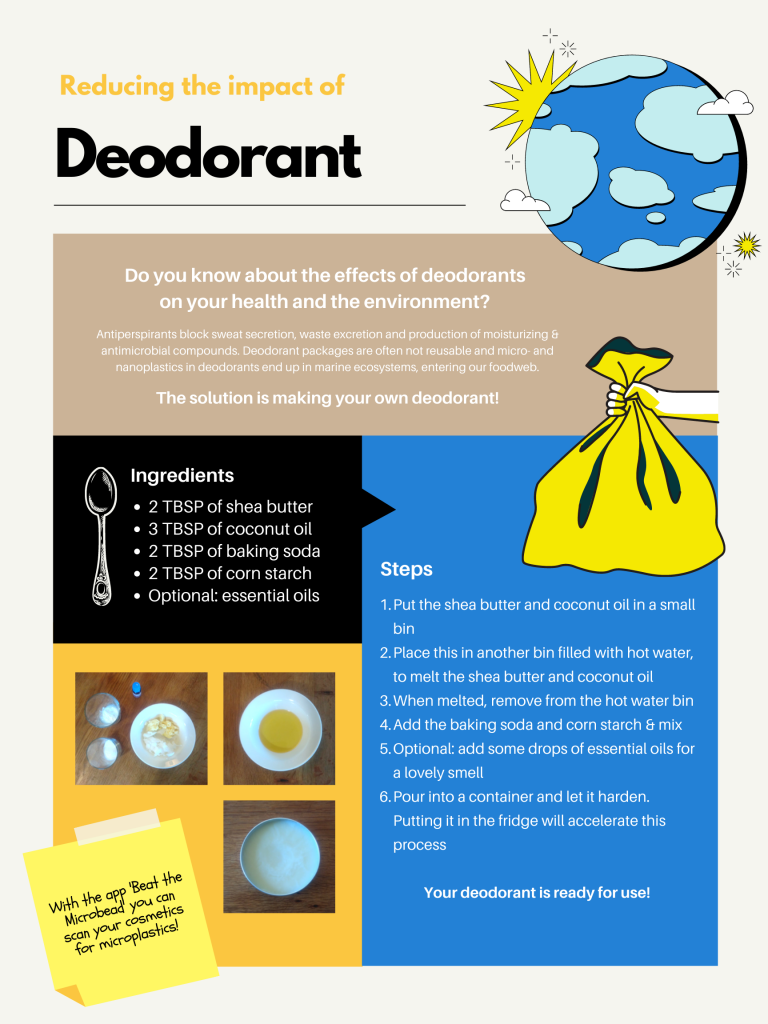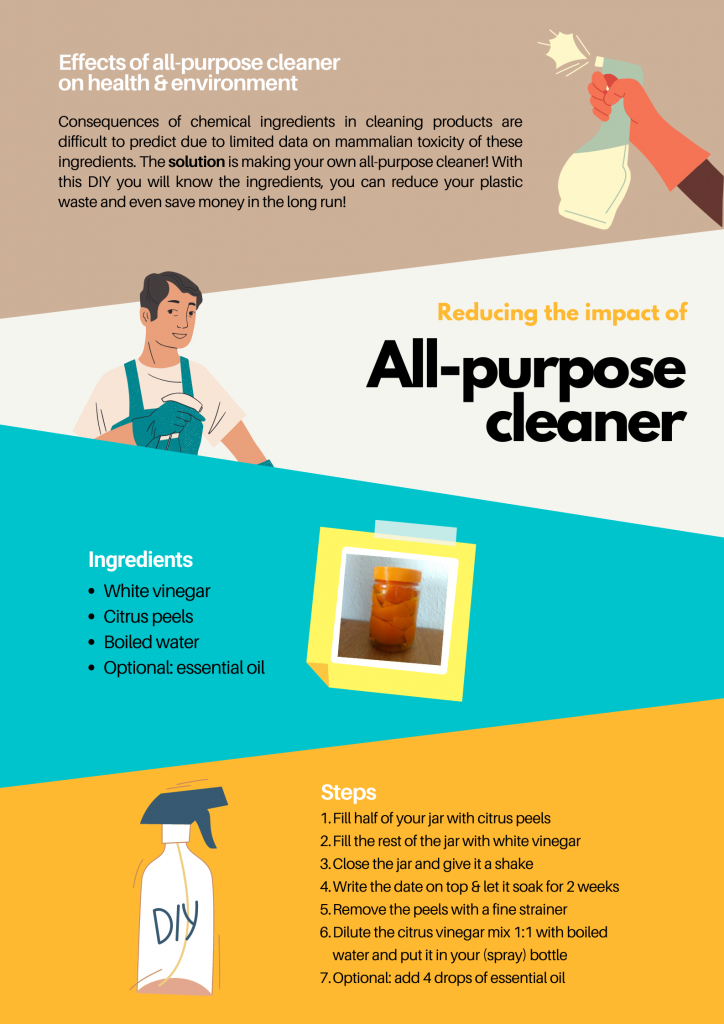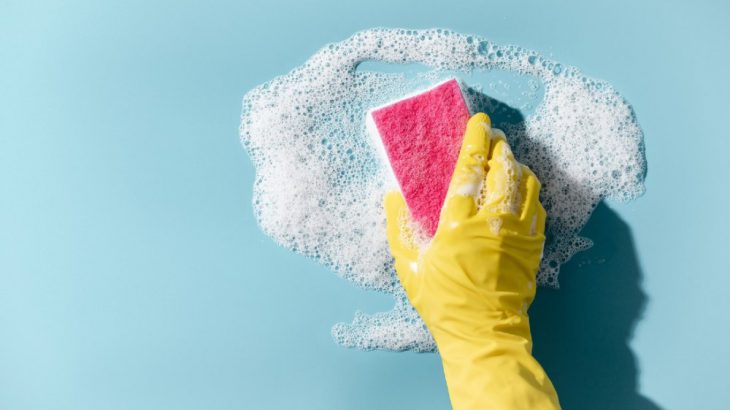Reducing the impact of deodorant & all-purpose cleaner on your health and the environment
Many people use deodorant and all-purpose cleaner, but do you know what these products contain? In this post you will discover the effects of deodorant and all-purpose cleaner on your health and the environment. You will also find out what you can do about it!
Deodorant
Important to know, is the difference between antiperspirants and deodorants. Deodorants only change your smell, while antiperspirants reduce perspiration and change your smell. The active ingredient in many antiperspirants is an aluminium salt such as aluminium chlorohydrate. Aluminium salts precipitate inside your eccrine sweat glands, producing an insoluble aluminium hydroxide that plugs the gland and blocks the sweat secretion 3.
You may think, what is the problem if I don’t sweat? Evaporation of sweat is important for body temperature regulation. Eccrine glands also produce moisturizing substances and antimicrobial peptides. Next to this, sweat glands have an excretory function, to get rid of metabolic waste and toxic compounds 2.
There is also the aspect of waste, as most deodorant packages are not sustainable or reusable. Your deodorant can also contain micro- or nanoplastics, which end up in marine ecosystems through our drainage systems. These small particles are easily ingested by organisms, harming the organisms and entering our foodweb 1.
You may wonder, how do I solve these problems?
To check your cosmetics for microplastics, you can scan the ingredient list with the app Beat the Microbead. Another solution is making the deodorant yourself! You will know what you put on your skin, reduce your (plastic)waste and even save money on the long turn. Here you will find a DIY (Do It Yourself) for a solid deodorant. Success!

Ingredients
- 2 tablespoons of shea butter
- 3 tablespoons of coconut oil
- 2 tablespoons of baking soda
- 2 tablespoons of corn starch
- Optional: essential oils
Steps
- Put the shea butter and coconut oil in a small bin
- Place this in another bin filled with hot water, to melt the shea butter and coconut oil
- When melted, remove from the hot water bin
- Add the baking soda and corn starch & mix
- Optional: add some drops of essential oils for a lovely smell
- Pour into a container and let it harden. Putting it in the fridge will accelerate this process
- Your deodorant is ready for use!
All-purpose cleaner
Have you always wondered whether your cleaning solutions are harmful for yourself or the environment? Or wondered what all those difficult names on the ingredient list actually mean? Due to limited data on mammalian toxicity of chemical ingredients used in cleaning products, risk assessment on chemical threats is challenging 4. This makes it difficult to predict the consequences of these chemicals on human health and the environment.
When you make your own cleaning products, you don’t have to wonder about this anymore! Below you will find two DIYs for all-purpose cleaner. With these DIYs you know exactly what is in your cleaning solution, you can reduce your plastic use and you can even save money! The first DIY is easier, for when you’re short on time. The second DIY takes a bit longer, but your hard work will give the all-purpose cleaner a nicer smell. Good luck!

Easy version
Ingredients
- Boiled water
- Vinegar
- (Spray) bottle
- Optional: essential oil
Steps
- Boil the water to make sure it is clean.
- Fill your (spray)bottle for 50% with the boiled water.
- Fill the other half of the bottle with vinegar.
- To add a nice smell to your cleaning solution, you can add some lemon peels or a few drops of essential oil, but this is not necessary.
Tip: Reuse your old cleaning bottles and buy vinegar in glass to make this DIY zero-waste!
Advanced version
Ingredients
- White vinegar
- Citrus peels
- Boiled water
- Optional: essential oil
- Jar
- (Spray)bottle
Steps
- Fill half of your jar with citrus peels.
- Fill the rest of the jar with white vinegar.
- Close the jar and give it a shake.
- Write the date on top & let it soak for 2 weeks.
- Remove the peels with a fine strainer.
- Dilute the citrus vinegar mix 1:1 with boiled water and put it in your (spray) bottle
- Optional: add 4 drops of essential oil.

This article was written for the course Empowerment for Sustainability (ELS-21806). If you try one of the DIYs, I would love to hear your opinion. Feedback and remarks are also very welcome! You can send this to elke.kleinholkenborg@wur.nl.
By: Elke Klein Holkenborg
References
1. Auta, H. S., Emenike, C. U., & Fauziah, S. H. (2017). Distribution and importance of microplastics in the marine environment: A review of the sources, fate, effects, and potential solutions. Environment International, 102, 165–176. https://doi.org/10.1016/j.envint.2017.02.013
2. Baker, L. B. (2019). Physiology of sweat gland function: The roles of sweating and sweat composition in human health. Temperature, 6(3), 211–259. https://doi.org/10.1080/23328940.2019.1632145
3. Benohanian, A. (2001). Antiperspirants and deodorants. Clinics in Dermatology, 19(4), 398–405. https://doi.org/10.1016/s0738-081x(01)00192-4
4. Wang, Z., Dinh, D., Scott, W. C., Williams, E. S., Ciarlo, M., DeLeo, P., & Brooks, B. W. (2019). Critical review and probabilistic health hazard assessment of cleaning product ingredients in all-purpose cleaners, dish care products, and laundry care products. Environment International, 125, 399–417. https://doi.org/10.1016/j.envint.2019.01.079



